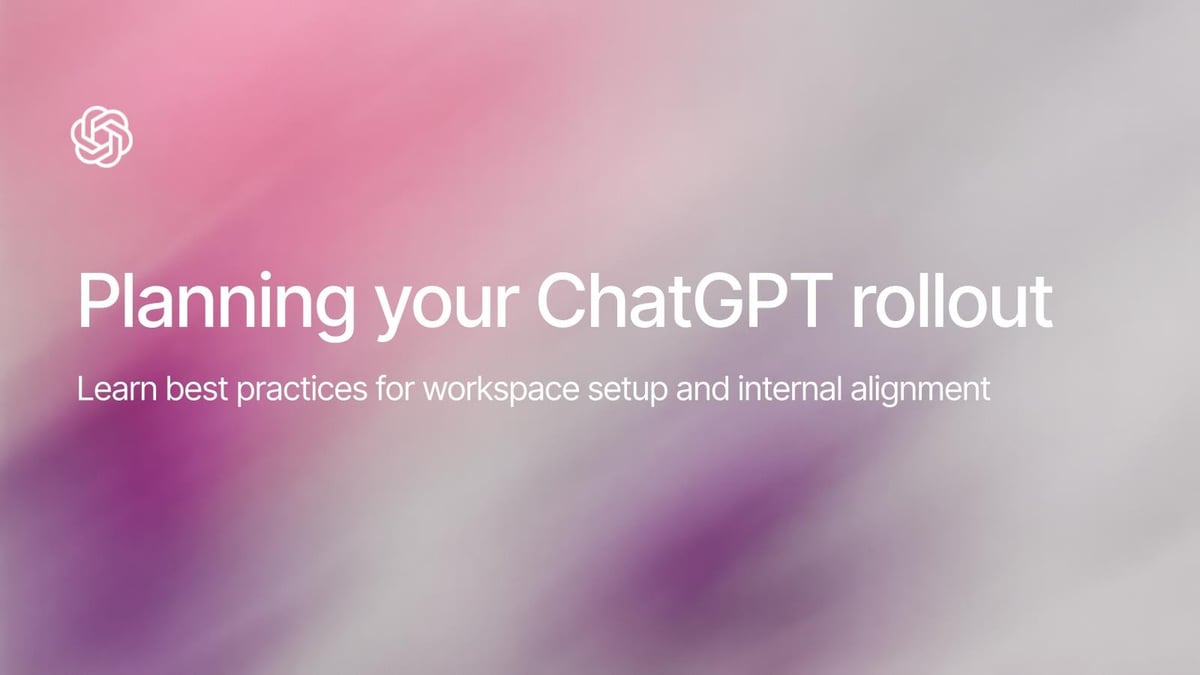Article
July 11, 2025 · Last updated on August 29, 2025
Planning your ChatGPT rollout

# Administrators
# Launch
Set up your workspace, build your internal team, and set your vision

Planning your rollout
Getting started with ChatGPT at work takes planning across teams. If you set up the right guidelines, tools, and training from the beginning, generative AI can better support your company’s goals and help people move naturally from just knowing about ChatGPT to trying it out to using it every day.
Set up your workspace
If you're owning the technical workspace setup, we recommend you review our comprehensive Admin Guides and Help Center resources to support the technical setup of your workspace.
Your top priority in your first few weeks should be getting users into the product. Activation is the first real moment of engagement, and every step leading up to that should be designed to reduce friction and build trust with new users. A compliant workspace is foundational—employees should be able to log in seamlessly and securely on day one.
Before sending your first invite:
- Determine how users will log in – Choose the authentication flow that best fits your security posture. Document the end‑to‑end steps, pilot with a small group, and ensure security controls are enforced before wide rollout. We strongly recommend setting up SSO (for all workspaces) and SCIM (for Enterprise workspaces).
- Review workspace settings (for ChatGPT Enterprise Owners) – Review global toggles for different ChatGPT features in the admin settings, which will apply to your entire workspace. See more about global workspace settings in our admin guide here.
Build your internal ChatGPT task force
ChatGPT is not merely a technical deployment—it’s a people-centered investment that requires behavior change and buy-in. Embedding trusted voices across functions accelerates adoption, mitigates friction, and positions ChatGPT as a strategic enabler across the organization.
Here are they key players in a successful ChatGPT deployment:
Role | Purpose | Recommended activities |
Executive sponsor | Sets vision, unblocks resources, and models usage | Publish and socialize a vision memo; partner with department leads to translate the vision into function‑specific goals, reference adoption and value metrics in company communications; secure budget and resources |
Project lead | Orchestrates rollout | Maintain the rollout plan; run regular cross-functional syncs; build and circulate impact reports; lead an internal champions group |
Executives and departmental leaders | Evangelizes the vision, models behavior, represents their teams | Run use case brainstorms, promote wins, nominate champions, encourage internal sharing |
HR & L&D | Builds culture and capability | Draft and circulate applicable AI policies; integrate training into the LMS; |
Workspace owners / admins | Provides workspace access and governance | Configure SSO, retention, and access controls; reviews permissions with new feature releases |
Champions | Drives grassroots adoption | Run demos and interactive activities; collect and share feedback from the field; share best practices; pilot advanced features; mentor new users |
Craft your ChatGPT vision and strategy
Leadership plays a critical role in making ChatGPT successful. Most organizations adopt ChatGPT for two key reasons: to see immediate value through efficiency and productivity, and to build AI skills that prepare teams for the future.
To support that, leaders should clearly communicate why ChatGPT matters and how it fits into broader business goals. Here are some key actions to create your ChatGPT vision:
- Anchor to business priorities – Start by mapping early ChatGPT initiatives to 2–3 existing strategic themes—like operational efficiency, faster customer support, or product innovation. Highlight a few specific pain points it can help solve. Employees should see a clear line from ChatGPT to the metrics that matter most. Which top‑line OKR(s) will generative AI accelerate?
- Prepare to measure impact – Establish a baseline using metrics that already matter to your teams — like average ticket resolution time or hours spent on RFPs. Track changes at 30/60/90-day intervals, and pair quantitative insights (e.g., usage dashboards) with qualitative feedback (e.g., surveys) to capture both breadth and depth of impact. What does “better” look like in 60 days? In 6 months?
- Articulate the employee value proposition – Frame ChatGPT as a tool that helps employees do their best work. It amplifies expertise, saves time, and frees people up for more creative, strategic, and collaborative work. Make it clear that AI is here to support talent—not replace it.
- Where is there friction or wasted effort?
- Why is ChatGPT uniquely positioned to solve real employee challenges?
- What compelling narrative will inspire adoption and experimentation?
This vision should be treated as a living, breathing document that evolves as your organization learns what works. Giving employees access in parallel can actually enrich this process—real usage uncovers both opportunities and friction points, helping leadership discussions stay practical, relevant, and aligned with their teams.
Document an AI use policy
As your organization begins using AI, employees will naturally have questions about what’s allowed, what’s encouraged, and how to use it responsibly at work. Here’s some best practices in using ChatGPT at Work.
- Require employees to double-check facts, edit AI-generated content, and take full ownership of final outputs.
- Clarify what can/can’t be shared with ChatGPT. Educate your employees about what kinds of data can be shared with ChatGPT, consistent with your company's data practices. For example, emphasize not inputting Protected Health Information, unless your workspace has signed a healthcare addendum.
- Spell out what's encouraged (e.g., summarizing docs, idea generation) and what's off-limits (e.g., relying on it for legal advice).
You also may choose to formalize an internal AI policy to share during your launch.
- Bring together an internal working group (Legal, Security, Privacy, HR, Comms, AI Champions) and review existing internal policies (data handling, information security, code of conduct, etc)
- Draft the policy and get sign-off with the internal working group. Run legal and other cross-functional reviews and obtain executive approval before sharing with employees.
- Publish in your policy repository and link it in onboarding materials. Create a review cadence to ensure you are incorporating new features or regulatory changes into your policy.
Next >> Empowering and supporting your team
Table Of Contents

